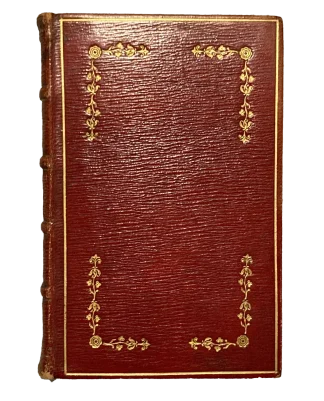OVID, Publius; SPRENG, Johannes.
Metamorphoses Ovidii argumentis quidem solute oratione Enarrationibus autem et allegoriis […]
Paris, Apud H. de Marnef & Gulielmus Cavellat, Paris, 1570.£2,250.00
16mo. ff. [16] 178 [6]. Roman and italic letter. 178 lively ½ page woodcuts in excellent impression, one at the head of each story. Author’s address to reader, one story per leaf, including title, summary of narrative and commentary. Printer’s phoenix device and autograph of ‘Hezeikiel Banaro cornus 1574’ to t-p, index and verse by Spreng at end. Lightly age yellowed, pages slightly trimmed, well clear of text. Armorial bookplate of John Broadley to ffep. A very good, clean, crisp copy in handsome c.1800 red morocco, gilt floral garlands to corners of covers, gilt to spine, a.e.g.
A finely adapted version of Ovid’s Metamorphoses in images, accompanied by a prose ekphrasis, followed by Latin verse distichs, closely based on the Ovidian texts with a verse commentary, by Johannes Spreng, a translator and notary from Augsburg, who worked on a variety of Classics, including the Iliad and Aeneid, translating them into German verse.
Completed around 8AD, and often hailed as Ovid’s magnum opus, the original text serves as a poetic encyclopaedia of over 250 myths, beginning with the creation of the world and concluding with the deification of Julius Caesar, over 15 books. Although an abridgement, this version remains faithful to the original, and is no less complete. The Metamorphoses remain the authoritative text for most historical reception of the Classical myths in literature and art.
This edition is dedicated to two members of the Habsburg family, Archdukes Rudolf (1552-1612) and Ernest (1553-1595) of Austria, sons of Maximilian II (1527-1576), whom Rudolf later succeeded as Holy Roman Emperor. The Habsburgs were known patrons of the arts, Philip II of Spain commissioned the painter Titian to create a series of artworks and was given complete creative freedom. He drew upon Ovid’s Metamorphoses, producing paintings between 1551-1562, known as his poesie, representing the stories of Europa, Diana and Actaeon, Danaё, Venus and Adonis, Callisto, and Perseus and Andromeda. A Habsburg interest in the classical myths seems to emerge, the first edition of Spreng’s text appearing in 1563, only a year after the completion of Titian’s final painting. Spreng’s native Augsburg was also one of the two places Philip met Titian face to face.
The composition of the scenes which feature in Titian’s poesie is strikingly similar to the illustrtations of this edition, pointing to the accurate visualisation of the original text. However, these differ from the first 1563 edition images by Virgil Solis (1514-1562), which employ more dramatic chiaroscuro, with weightier, more detailed figures. The present cuts are the same as the 1566 edition in that the composition is inverted and with less dramatic rendering of light and shade.
Spreng’s ‘allegoria’ reveal his interpretation of each story. For instance, ‘in Apollo, who pursues Daphne, [he] sees Satan, who preys on the soul of man, and who reads from the death of Semele in Jupiter’s arms only the harmful consequences of the libido’. Just as in Titian’s poesie, the myths were viewed through a Christian lens, with the intention of moralising potentially scandalous classical subject matter, which was so popular during the Renaissance.
A stunning interpretation of the quintessential lore of Classical mythology with an additional Renaissance flourish.
USTC: 199775; Brunet: IV 276; Pettegree: 81419; GGB: p. 290; Graesse: V 76; edition unrecorded in Adams, not in BM catalogue or Mortimer.In stock





